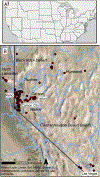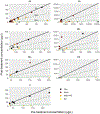Naturally occurring metals in unregulated domestic wells in Nevada, USA
- PMID: 36029812
- PMCID: PMC9588670
- DOI: 10.1016/j.scitotenv.2022.158277
Naturally occurring metals in unregulated domestic wells in Nevada, USA
Abstract
The dominant source of drinking water in rural Nevada, United States, is privately-owned domestic wells. Because the water from these wells is unregulated with respect to government guidelines, it is the owner's responsibility to test their groundwater for heavy metals and other contaminants. Arsenic, lead, cadmium, and uranium have been previously measured at concentrations above Environmental Protection Agency (EPA) guidelines in Nevada groundwater. This is a public health concern because elevated levels of these metals are known to have negative health effects. We recruited individuals through a population health study, the Healthy Nevada Project, to submit drinking water samples from domestic wells for testing. Water samples were returned from 174 households with private wells. We found 22 % had arsenic concentrations exceeding the EPA maximum contaminant level (MCL) of 10 μg/L. Additionally, federal, state, or health-based guidelines were exceeded for 8 % of the households for uranium and iron, 6 % for lithium and manganese, 4 % for molybdenum, and 1 % for lead. The maximum observed concentrations of arsenic, uranium, and lead were ∼80, ∼5, and ∼1.5 times the EPA guideline values, respectively. 41 % of households had a treatment system and submitted both pre- and post-treatment water samples from their well. The household treatments were shown to reduce metal concentrations, but concentrations above guideline values were still observed. Many treatment systems cannot reduce the concentration below guideline values because of water chemistry, treatment failure, or improper treatment techniques. These results show the pressing need for continued education and outreach on regular testing of domestic well waters, proper treatment types, and health effects of metal contamination. These findings are potentially applicable to other arid areas where groundwater contamination of naturally occurring heavy metals occurs.
Keywords: Drinking water; Heavy metals; Private well.
Copyright © 2022 Elsevier B.V. All rights reserved.
Conflict of interest statement
Declaration of competing interest The authors declare that they have no known competing financial interests or personal relationships that could have appeared to influence the work reported in this paper.
Figures






References
-
- Anning DW, Paul AP, McKinney TS, Huntington JM, Bexfield LM, Thiros SA, 2012. Predicted nitrate and arsenic concentrations in basin-fill aquifers of the southwestern United States. US Department of the Interior, US Geological Survey, Scientific Investigations Report 2012–5065.
-
- Ayotte JD, Gronberg JM, Apodaca LE, 2011a. Trace elements and radon in groundwater across the United States, 1992-2003. US Department of the, US Geological Survey, Scientific Investigations Report 2011–5059.
-
- Ayotte JD, Szabo Z, Focazio MJ, Eberts SM, 2011b. Effects of human-induced alteration of groundwater flow on concentrations of naturally-occurring trace elements at water-supply Interior wells. Applied Geochemistry 26, 747–762, 10.1016/j.apgeochem.2011.01.033. - DOI
MeSH terms
Substances
Grants and funding
LinkOut - more resources
Full Text Sources
Medical
Research Materials

